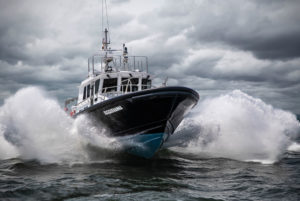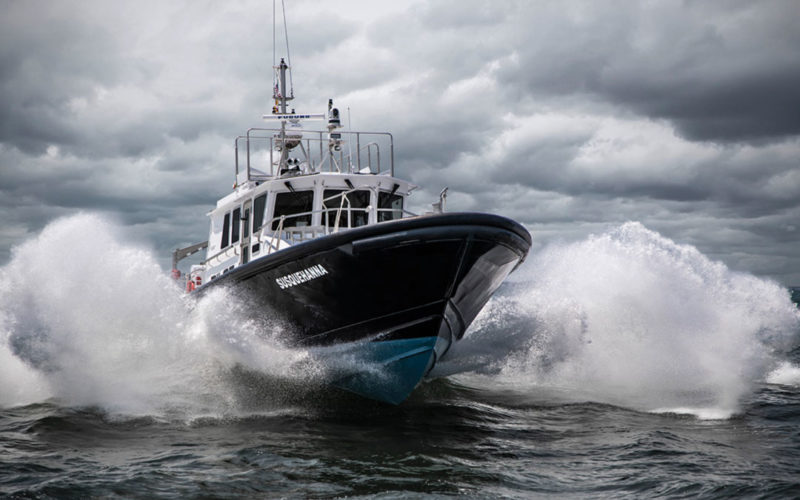
The Los Angeles Pilot Service serves the busiest seaport in the United States. Two new launches will help its pilots move more efficiently and more comfortably from ship to ship.
The 55-by-19-foot Angels Pilot and Angels Navigator replace two smaller vessels built 26 years ago by Willard Marine. Vigor Industrial built the new pilot boats in Vancouver, Wash., using proven plans from Camarc Design.
“We took delivery of the boats in November of last year and placed them into service at the end of December,” said Capt. Craig Flinn, who oversaw vessel acquisition for the group of 16 pilots. “Our first week using the boats, we ran right into 10-to-15-foot seas, and the boats handled like a dream. The guys were able to cruise at 17 knots in the heavy seas.”
The Los Angeles Pilot Service, as the name suggests, guides vessels in and out of the Port of Los Angeles. Its longest runs are no more than 5 miles from shore, but the sheer number of transfers occurring throughout the day is a primary challenge.
“We are constantly taking guys off and putting them on, so we need the ability to get around rapidly,” he said. “I wanted the ability to cruise at 21 with a max speed of 27 knots, so if we had to, we could put the hammer down and jump from ship to ship. These boats have that capability.”
The two previous pilot boats, Phineas Banning and Stephen White, topped out at 23 knots “on a good day,” Flinn said. Both have been removed from active service.
Angels Pilot and Angels Navigator have seating for eight pilots. They run with a two-person crew consisting of a deck hand and operator.
Propulsion on Angels Pilot and Angels Navigator consists of two Tier 3 Caterpillar C18 ACERT engines producing 803 hp. Those twin mains are matched to ZF gears turning 30-inch five-bladed propellers through 3-inch Aquamet stainless-steel shafts. Electrical power comes from a 15-kW Kohler generator.
Humphree interceptors with automatic trim, list and ride control features improve efficiency and comfort. An Aquadrive thrust bearing system also helps reduce noise and vibration. Stidd shock-mitigating seats reduce jostling between jobs.
The wheelhouse is equipped with the latest Furuno navigation electronics and Icom VHF radios. Below deck in the forecastle, the vessels have a small fridge and sink, along with a head and storage space.
Out on deck, both launches are equipped with a Harken fall-arrest system to prevent pilots from going overboard. In the event of a water rescue, the two vessels have a man-overboard retrieval system installed at the transom.
“If someone goes over the side, the boat crew can get out there, drop it down and utilize the aft controls to back down and scoop guys out of the water,” Flinn said.
After nearly nine months with the pilot boats, he said there is a clear consensus around the new vessels: “We love them.”
Susquehanna
Fells Point wasn’t the only new pilot boat the Association of Maryland Pilots welcomed into its fleet within the past year.
Last December, the Baltimore-based pilotage group added the 53-foot Susquehanna to its offshore fleet based in Cape Henry, Va. It is the fourth Chesapeake-class launch operated by the group.
Ray Hunt Design provided plans for the new boat, and it was built in Somerset, Mass., by Gladding-Hearn Shipbuilding. It features the same deep-V hull as its predecessors.
The propulsion chain consists of two 641-hp Volvo Penta D16 engines paired with Bruntons propellers and ZF gears. Humphree provided interceptors that feature an automatic trim optimization system. Susquehanna’s top speed exceeds 26 knots.
The wheelhouse has the latest Furuno electronics and Norsap seats. Below deck, the forecastle has a settee, portable head and storage for immersion suits and other equipment. The decks and handrails are heated to prevent ice accumulation during the winter months.
Susquehanna, like its smaller sibling Fells Point, has a custom J-basket installed at the transom for man-overboard rescues. The unit lowers roughly 18 inches below the surface, allowing the operator to safely lift an unconscious person from the water.
Since the introduction of the Chesapeake class, Gladding-Hearn has delivered 22 of the launches to 12 pilot groups. The Association of Maryland Pilots and Virginia Pilot Association were customers for the new design in 2003.
Serac
Armstrong Marine built the 45-by-16-foot Serac for the National Park Service. It is used for personnel and pilot transfers within Glacier Bay National Park and Preserve.
Jutson Marine Design of Vancouver, British Columbia, provided plans for the aluminum semi-displacement catamaran.
The propulsion package consists of twin 200-hp John Deere diesel main engines driving nibral propellers through ZF gears. Glendinning provided the controls, while the Optimus EPS steering system is from SeaStar Solutions. The wheelhouse is equipped with a Furuno navigation electronics package.
Serac is designed with a raised pilothouse with forward and overhead windows for improved visibility. There is seating for two crew and four pilots in the pilothouse, while the heated main cabin has bench seating for 12 people. The vessel also has a hot-water head and a dinette that converts to a double berth.
The exterior is equipped with LED floodlights and recessed lights under the gunwales.
Ybor
The Tampa Bay Pilots added a versatile new launch to its fleet with the 32-foot Ybor.
The pilot group put the foil-assisted aluminum catamaran into service in April. It is used to transfer pilots from inbound and outbound ships, as well as vessels that shift terminals within upper harbor, said Terry Fluke, the group’s executive director.
“She has significantly increased efficiency transporting pilots in the upper harbor versus shoreside vehicle transportation across congested roadways,” he said in an email.
Ybor is powered by twin 300-hp Yamaha outboard engines, while a single Northern Lights generator produces up to 5 kW of electricity. The navigation package consists of a Furuno NavNet TZtouch2 multifunction display and Icom 330 VHF radios.
The fully enclosed wheelhouse has seating for the operator and four pilots. The exterior is illuminated with LED lights, and the bow has a railing along the centerline for pilot transfers.
ACI Boats in Port Townsend, Wash., built Ybor using a design from Jutson Marine. —Its top speed approaches 40 knots.
FIREBOATS
Metal Shark delivers
notable new fireboats
Miami-Dade Fire Rescue took delivery of two 55-foot fireboats that expand its capabilities in South Florida.
Fireboat 21 and Fireboat 73 were designed and built by Metal Shark in south Louisiana using an in-house design. The new vessels were built to standards set by Lloyd’s Register, and they replace two existing fireboats within the department.
Propulsion on the lime-green aluminum-hulled vessels comes from twin 1,200-hp MAN engines paired with Marine Jet Power waterjets through ZF gears. The Zipwake dynamic trim and ride control system improves efficiency, stability and comfort underway, according to Metal Shark. Their top speed exceeds 44 knots — faster than the department’s existing fireboats. Electrical power comes from a Kohler genset.
The advanced firefighting package on Fireboat 21 and Fireboat 73 starts with two Darley ZFE 3000 pumps driven by the MAN engines. They can flow up to 8,500 gallons per minute to a remote-controlled Elkhart Brass Spit-Fire rooftop monitor and two aft-mounted Elkhart Copperhead monitors. The vessels also have two aft handline outlets and 5-inch Storz connections fore and aft that can supply shoreside units. Another 3-inch outlet at the bow can flow to a Task Force Tips Extend-a-Gun monitor. Firefighting foam is stored in two 55-gallon reservoirs.
The wheelhouses are equipped with a Raymarine electronics package anchored by 12- and 16-inch Axiom multifunction displays at each of the three dash stations. These units display radar, GPS and key data from the engines, as well as video from a FLIR M400XR thermal imaging camera. A separate 12-inch Humminbird Helix display shows depth, sonar and images from a 3D side-scanning sonar, according to Metal Shark.
Elsewhere in the interior, there is seating for up to 16 people and space to transport up to three people on protective backboards. There are Shoxs seats for the four firefighting crew, along with a sink and marine toilet. The space is protected against chemical, biological, radiological, nuclear and explosive (CBRNE) threats.
“These new vessels were selected by Miami-Dade Fire Rescue following a lengthy procurement process and countless hours of research and development to provide our crews with the safest, most modern and efficient maritime firefighting platform available in the market,” Miami-Dade Fire Rescue Marine Services Chief Andy Alvarez said in a statement.
“We are thrilled,” he added, “to put these state-of-the-art, high-performance fireboats to work for the over 2.7 million residents of Miami-Dade County.”
Fire Boat 2
Orange Beach Fire and Rescue has added a new fireboat that will protect one of the busiest beaches in Alabama.
The 43-by-12-foot Fire Boat 2 is one of the first Defiant 38 NXT vessels to enter service. The new design from Metal Shark builds on the proven Defiant 38 platform used by fire departments, police and the military. It maintains the same hull form with an entirely new topside arrangement, Metal Shark said.
Propulsion on the new fireboat comes from two 550-hp Cummins QSB6.7 engines paired with HamiltonJet HTX 30 waterjets through Twin Disc gearboxes. It cruises at up to 30 knots and can exceed 40 knots at full throttle.
For firefighting equipment, Fire Boat 2 has two 1,500-gpm Darley pumps feeding a remote-controlled Elkhart Brass Scorpion EXM rooftop monitor and two manually operated Elkhart Copperhead units aft of the pilothouse. There are two handline outlets and a single 5-inch Storz hose connection.
Fire Boat 2 operates in and around Orange Beach, a town of 6,100 people that swells with tourists during the warmer months. Its duties include fire response and waterborne rescues and transports.
Metal Shark has several other Defiant 38 fireboats under construction for the Chicago Fire Department and South King County Fire and Rescue, among others.
Fireboat 16
Lake Assault Boats of Superior, Wis., delivered several new fireboats over the last year, including Fireboat 16 for Sherrills Ford-Terrell Fire and Rescue Department near Charlotte, N.C.
The 28-foot aluminum vessel works on Lake Norman, which has almost 520 miles of shoreline. The waterbody has numerous marinas and parks, and some 30,000 boats are registered on the lake.
Fireboat 16 is powered by two 350-hp Mercury Verado outboard engines with joystick controls and one-touch Skyhook virtual anchoring system, Lake Assault said in a news release. Garmin supplied the navigation electronics, and the vessel’s rescue equipment includes a FLIR camera.
The firefighting package on board consists of a 1,500-hp Darley fire pump driven by a dedicated V-8 engine flowing water to an Elkhart Brass monitor. Fireboat 16 has twin 4-inch discharges and a firefighting foam system.
Lake Assault also delivered a 26-foot fireboat to the Bartow County Fire Department in Georgia, and a 36-foot fireboat that operates at Marathon Petroleum’s refinery in Garyville, La.
Marine 1
The Danbury Fire Department in Danbury, Conn., has taken delivery of a 32-foot fireboat from Silver Ships of Theodore, Ala.
Marine 1 is powered by two 250-hp Suzuki outboard engines and can reach 37 knots. It has an enclosed walkaround cabin equipped with Raymarine navigation electronics. Its fire pump can dispense 1,000 gallons per minute through a forward-facing monitor.
Other features include two dive doors, floodlights, searchlights and heavy-duty towing equipment.
PATROL BOATS
Lake Assault begins deliveries for large Navy order
Lake Assault Boats of Superior, Wis., has completed the first force protection-medium patrol boat for the U.S. Navy in an order that could grow to 119 vessels and $56 million. Additional deliveries are likely through 2021 and beyond, the shipyard said.
The lead boat in the 33-by-10-foot series is powered by two 225-hp Yamaha engines. They have a full cuddy cabin, Furuno navigation electronics and a FLIR camera.
According to Lake Assault, the class of patrol boats is designed to protect U.S. Navy ships and personnel within port facilities around the world.

